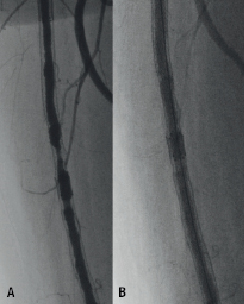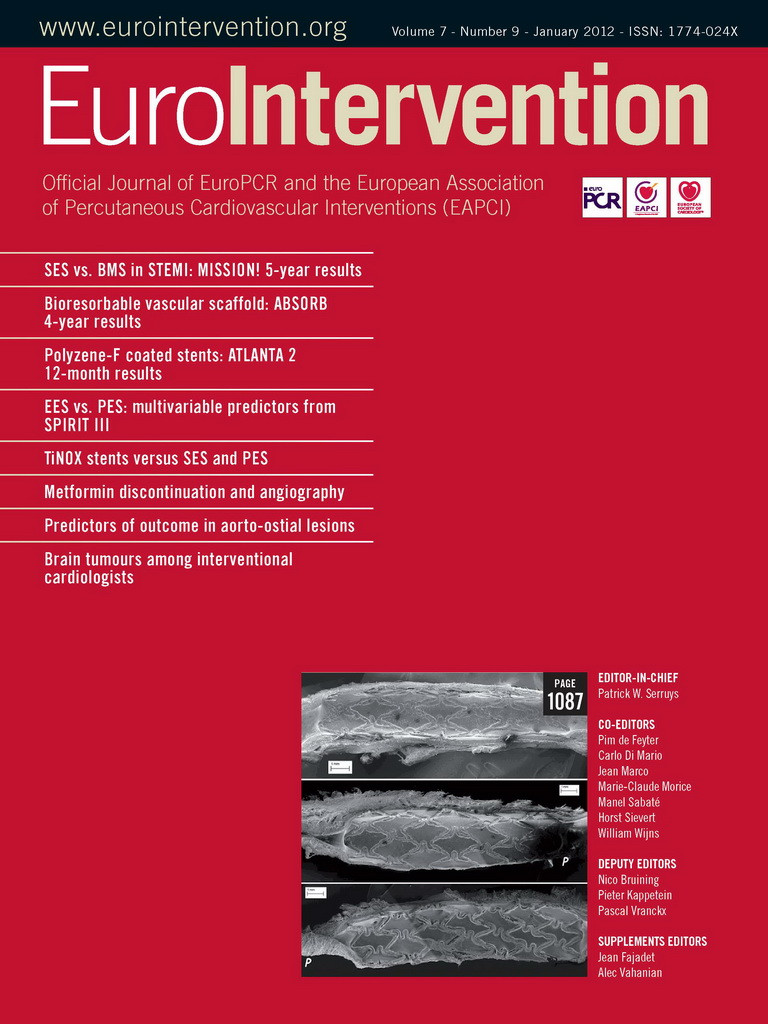Background
Above the knee (ATK) angioplasty is usually performed via transfemoral access employing the crossover technique. When, occasionally, the crossover approach cannot be pursued due to anatomic constraints, the transbrachial access has been used as an alternative. However, transbrachial access is associated with frequent complications, especially when used by operators not familiar with this approach.
Transradial access (TRA) is being increasingly employed for percutaneous coronary interventions. Until now, angioplasty on ATK arteries by TRA has been limited by the inadequate length of available devices, though recently, longer devices have become available. The aim of this paper is to describe the materials and techniques for a successful ATK angioplasty by TRA.
Indications
TRA can be used for ATK angioplasty as the alternative to a difficult transfemoral access. However, TRA could become a routine access for treating intrastent restenosis (Figure 1A and Figure 1B) or addressing bilateral lesions within the same session.

Figure 1. The patient, 78-year-old, presented with a recurrence of left claudication, Rutherford category 2, intrastent restenosis 10 months after stenting of his left SFA (A) The left common iliac artery was engaged with a 125 cm long, 6 Fr guiding catheter (Multipurpose; Cordis, Johnson & Johnson, Warren, NJ, USA) by left TRA; the lesion was crossed with a 400 cm long, 0.018”, soft tip wire (Plywire; OptiMed, Ettlingen, Germany); (B) the stenosis was successfully dilated with a 0.018”-compatible 5.0/120 mm balloon (Pacific Extreme; Medtronic, Minneapolis, MN, USA).
Difficulties
We use a 120 cm introducer system for steadily engaging the iliac arteries and 300-400 cm long wires (variably performing) to cross the lesions themselves. In our armamentarium are balloons and stents with 180 cm long shafts to dilate lesions and cover flow-limiting dissections. On the contrary, today we still lack support catheters longer than 150 cm to aid the progression of these wires and to cross the lesions. Finally, debulking and crossing systems need to be developed with long shafts for approaching long and calcified lesions, or aggressive intrastent restenosis.
Methods
For treating ATK vessels by TRA, the left radial artery is to be preferred because the path to the aortic bifurcation is shorter. There are three options to select the common iliac arteries by TRA. First, the radial artery can be cannulated with a 6 Fr radial introducer, the common iliac arteries can then be engaged with a125 cm long, 6 Fr guiding catheter (Multipurpose; Cordis, Johnson & Johnson, Warren, NJ, USA). A second option is to use a120cm long, 5 Fr sheath (Epsylar; OptiMed, Ettlingen, Germany). A third option is to employ a 120 cm long, 8.5 Fr sheathless guiding catheter (SheathLess PV; Asahi Intecc, Aichi, Japan).
For ATK angioplasty, only 0.018”, 300 cm long wires can be used (e.g., V18; Boston Scientific, Natick, MA, USA; Treasure 12 and Astato 30; Asahi Intecc, Aichi, Japan). As soon as the lesion is crossed, these aggressive wires can be exchanged and position maintained with a 400 cm long, soft tip wire (Plywire; OptiMed, Ettlingen, Germany).
At the present time there are two over-the-wire, 0.018” compatible balloons with a 180 cm long shaft: Dilexx-18 (OptiMed) and Pacific Extreme (Medtronic).
Finally, in order to cover flow-limiting dissections, the OptiMed sinus-SuperFlex-518 is the only self-expanding nitinol stent system with a 180 cm long shaft. For treating ostial common iliac arteries lesions, balloon-expandable stents with a 135 cm long shaft usually suffice (OMNILINK Elite; Abbott, Abbott Park, Il, USA).
Conflict of interest statement
The authors have no conflict of interest to declare.

